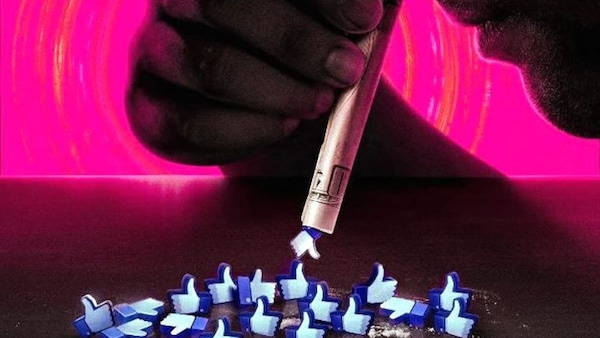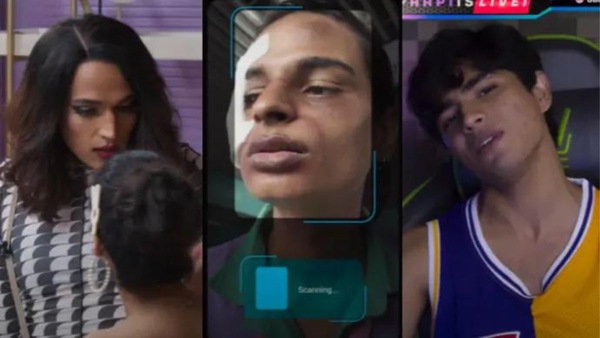Dibakar Banerjee’s Love Sex Aur Dhokha 2 Is A Pulsating & Chaotic Film Of Our Times
LSD 2 unfolds as a frenzied fever dream explicitly designed to ape the digital chaos we have to inhabit and concludes with a peek into a dystopic future we are hurtling towards.

Last Updated: 12.34 AM, Apr 20, 2024
DIBAKAR BANERJEE has been in sort of an artistic exile. His last film, Sandeep Aur Pinky Faraar released mid-pandemic in 2021 after facing unending Covid-related delays. Later, it dropped on streaming just as noiselessly. In the interim, Netflix commissioned and shelved Tees — Banerjee’s new work in which he tracked three generations of an Indian family — on the grounds of it being “too risky” in the present political climate. Love Sex Aur Dhokha 2, a thematic sequel to his experimental 2010 outing, is his first feature film in three years that comes after all the beating. Given everything he has made and everything he went through, LSD 2 carries the dual burden of reputation and reaction. During its runtime, it resists succumbing to the legacy but unravels as this strange, uncontrollable beast that, in all its messiness, feels like a definite clapback.
LSD 2 is a film of our times that pulsates with the concerns of the present by aiming its gaze at the future. It is borne out of the same seed as its predecessor but through its manic vitality acknowledges that the world in the last decade has inexorably altered. If the characters in LSD, which was the first film in India to be shot in a digital format, were still discovering their relationship with the camera and treating it with the caginess one reserves for a new toy, the people in LSD 2 are implicitly and inherently attuned to the presence of a gaze. The camera here is not just a character but the whole plot.
Take for instance the first segment (the format of three interconnected sections is repeated) in which the premise centres on a show called “Truth Ya Naach”. Designed as an amalgamation of a voyeuristic franchise like Bigg Boss and dance shows like Dance India Dance, Truth Ya Naach is this all-consuming reality television where the contestants either have to tell a truth or dance to avoid being eliminated (Anu Malik, Sophie Choudry and Tusshar Kapoor are cast as the judges in a genius move). The implication here is that both have to be as engaging as the other. One of the participants is Noor (Paritosh Tiwari), a dancer who is transitioning to a woman. Her story of acceptance by her mother (a terrific Swaroopa Ghosh) plays out on, and for, national consumption.

In the second one, a transgender toilet cleaner of a metro station called Kullu (Bonita Rajpurohit) is found in a battered state by an influencer. The latter found her lying in a field when he had taken his dog for a walk. This broadcast of Kullu’s incident not just compels the participation of the higher authorities but brings critical attention of the cops, all of which ends up upending her life.
The third section revolves around a teenage gamer, Shubham (Abhinav Singh) who goes by the screen name GamePaapi and has dedicated his life to the camera. He has framed his albino uncle as this foreign-returned manager. His millions of followers are invested in his life. He plays virtual games with them, interacts and presents to them a more strident version of himself that comes under the scanner when some of his deep fakes, insinuating queerness, are circulated.
Written by Prateek Vats, Shubham (the team behind the terrific Eeb Allay Ooo!) and Banerjee, LSD 2 unfolds as a frenzied fever dream explicitly designed to ape the digital chaos we have to inhabit and concludes with a peek into a dystopic future we are hurtling towards. One scene briskly cuts away to another, mimicking our short attention span, and the camera becomes the giant representation of the many screens we watch daily. The film unravels in this logic. At all times, there is a deliberate sensory overload, replicating the sonic and visual grammar we are trained to consume. (Anand Bansal of Gamak Ghar and Riju Das of All That Breathes are the cinematographers). If we are looking at a news channel, there is a ticker at the bottom, there are advertisements on the side, and then there is also a poll asking you to vote for a reality show. If we are looking at a YouTube interface, then the related search on the sides includes bizarre videos like, “underarm pinching contest”.
If LSD 2 pulls up our screens on screen, it also offsets none of the subjective crudeness with prude objectivity. Our predatory visual instincts inform creative decisions. Who the film chooses to show reflects closely who we want to see. Consider the people occupying the narrative centre in the three segments: a transitioning female, a transgender woman, and an alpha-male, cuss-word-aficionado gamer. By showcasing their lives, at least holding out the promise of it. Banerjee peeks into our search history. He both winks at us and stokes our perverse curiosity.
But the more unsettling bit about LSD 2 is not the film looking at us in the eye and broadcasting our private interests. Instead, it is the filmmaker carefully crafting details in the stories, all of which suggest one thing: if the camera is looking at us, we too are looking at it. The gaze is less intrusive and more collaborative, like a dance on good days and a duel on bad. There are easy proofs in the first section where each act by the contestants in the reality show is voted by and reacted to by the millions of breathless audience. Noor does the same. She curates her reality — a love triangle with a fellow roommate, bringing her mother into the picture — for an eager crowd. At one point, one of the judges stands up and applauds, “What a reality!”

LSD 2 envisions a camera-stacked world where reality is an escape from realism and what we see (and show) of ourselves and others counts as the only truth. The commentary is embedded in the careful choices. Like an upper-class single mother (Swastika Mukherjee) fighting for a transgender woman only till her idea of righteousness is not threatened. Once that happens, she not only withdraws but combats like a young teenage influencer retreating into a virtual world once subjected to cyber abuse. The technical design of the film, shot entirely through point-of-view shots, supplements the reading.
Not everything in LSD 2 lands. It gets chaotic by the minute and resists coherence by the end. But the subtext informs the form. The film documents the digital jungle we have come to inhabit, which itself refuses to make sense. Banerjee’s new, riveting work shows us what India sees and what India is shown. A news anchor wears a virtual reality headset and flails her arms on national television, a battered body of a transgender woman is live-streamed for views. Between them lies a tiny glimmer of what India is not shown. The camera does not reach there and even if it does, no one would like, share and download that content.
